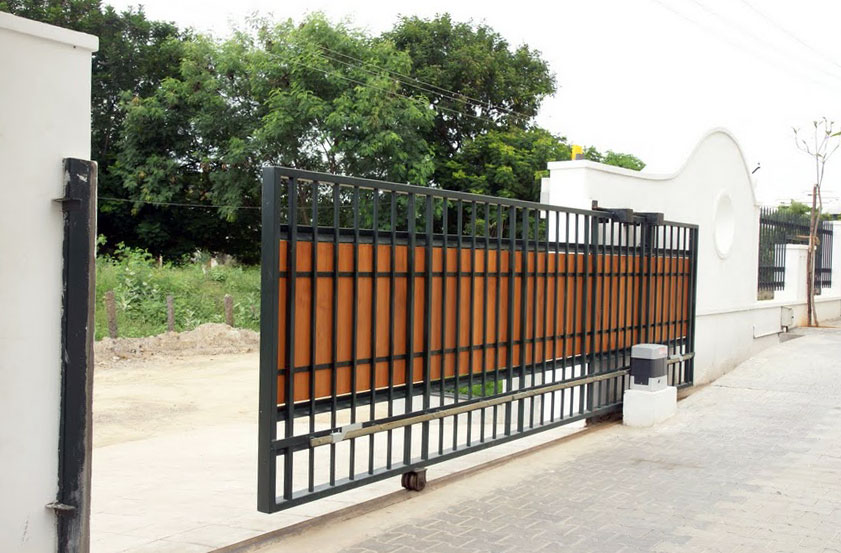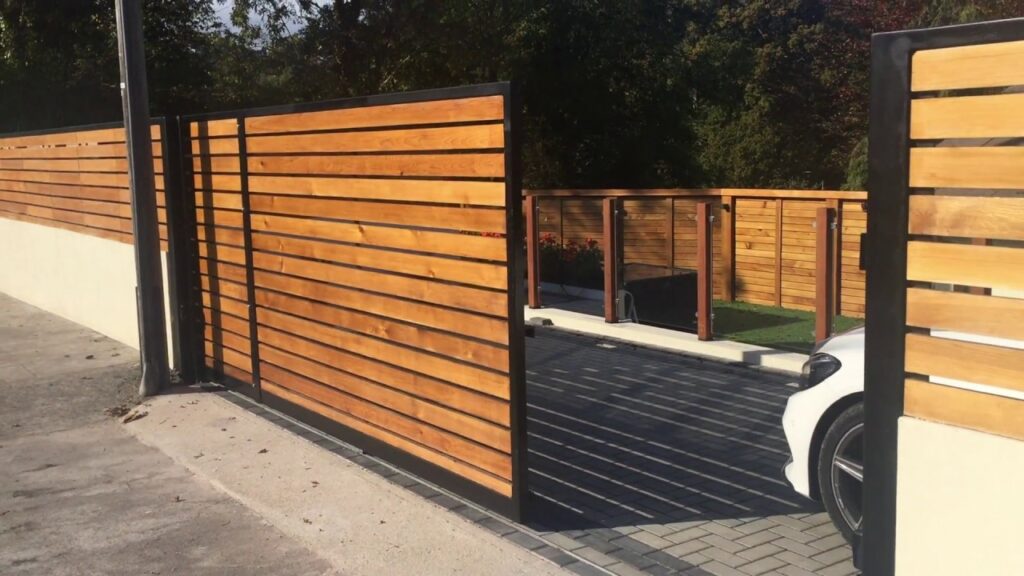Have you been searching to know what the advantages and disadvantages of sliding gates are? Or the applications of sliding gates and how it works? This post explores the advantages and disadvantages of sliding gates, together with its applications.

Sliding gates are a type of gate that can slide open and shut to allow or prevent passage. They are straight-flanged gates that move along tracks and are generally operated electrically or mechanically. Sliding gates make up a class of top-track electric barriers, while the term may also refer to other types of entry barrier that can move in response to an applied actuator force.
The primary purpose of a sliding gate is to provide security. They are typically used in industrial or commercial settings, and may be used with other security solutions such as high-security doors and fences.
In some cases, they may be part of an integrated system that includes interlocked locking devices, door access control systems, computer-controlled locking devices and sensors, automated egress systems, fire protection systems and access control gates.
While sliding gates provide security benefits by preventing unauthorized entry/exit into buildings or other premises due to reduced opening time, they also pose a threat by resulting in increased costs for the long-term maintenance of the equipment due to the higher wear rates than rolling type gates.
What Are Sliding Gates?
Sliding gates are similar to swing gates, in that they can open and close. However, a sliding gate moves in only one direction. It can slide back and forth if it is placed in a track, or swing outwards on hinges if it is not.
In both cases, this type of gate is ideal for industrial settings like warehouses or manufacturing facilities. The moving parts allow the gate to be accessed from either side of a doorway without having to remove it from the wall completely when it needs access from both sides at once.
Unlike swing gates, however, sliding gates are used in restricted areas such as factories and warehouses where people must move through to enter the facility. They still have the capability of being opened and closed, but generally will not be left open while cars are being driven through.
Sliding gates also allow for a wider variety of approaches than the narrower swinging doors can because they can be moved from side to side. This allows for greater flexibility in the opening or closing of a gate.
Some other types of sliding gates include electrically operated doors that can open with a touch of a button or device triggered by proximity sensors like those used on gas meters. These devices can be used to open the gate with a foot switch installed in one of the gates, or they can be used to activate a remote control, such as those attached to towing vehicles.
The electrical sliding gates are generally easier to operate than mechanical ones since they don’t need any moving parts to open or close. Any electrical equipment needed for them can be located inside the gate and connected by a cable, which is also what is used for closing the gate at the end of its use.
These doors move along steel tracks and may slide-open or into position when they are powered on. Electrical sliding doors are often used in warehouses, stores and offices. Since they are automated, they are also more efficient than manual doors.
Sliding gates may be referred to by other names including sliding rollers gates, folding gates, poly-track gates or central pivoting gates. The main differences between these types of gate is the way that they open and close.
Moving forward, now we have has good knowledge on what sliding gates are, let’s dive into the advantages and disadvantages of sliding gates.
Advantages And Disadvantages Of Sliding Gates
Here, we will be talking about the advantages and disadvantages of sliding gates but firstly, we will look into the advantages of sliding gates and the later its disadvantages.

Advantages Of Sliding Gates
Some of the advantages of sliding gates are as follows:
1. Easy To Handle
Sliding gates are easier to handle when it comes to situations that involve frequent opening and closing of the gate. Unlike other types of gates, sliding gates do not require any form of power source, or an operator to keep the gate opened or closed.
Since the sliding gate is made up of solid materials like steel, it cannot be easily damaged, and is thus very effective when it comes to security. Sliding gates also have a variety of lengths and widths available which means they can easily be custom fit for a wide range of applications.
2. Can Be Used In Various Environments
With their ease of handling, sliding gates are suitable for many types of situations, not just limited to industrial areas. They can be used in single or multi-storey applications, and can be made longer or shorter as the need arises.
These barriers can survive any kind of weather whether it is hot or cold because they are made from solid materials. Therefore, they are not easily damaged and can withstand even the toughest of weather conditions.
In some cases, sliding gates may be used in combination with other security solutions such as high-security doors and fences.
Sliding gates can also be combined with electronic locking devices and controlled by a central computer that issues access codes to individual users, or fire protection systems and access control systems.
3. Easy To Install
The sliding gate is also an effective way of fulfilling various industrial needs such as, domestic storage and security. As mentioned earlier, the sliding gate is easy to install because it has a variety of lengths and widths available. Also, the sliding gate can be produced with a high degree of customization to fit in any application.
As mentioned earlier, they are made up of solid materials that do not easily dilapidate and thus can be installed on door frames without damaging them.
Sliding gates are designed in a way that they blend in with most residential or commercial applications, and have aesthetic value as the barriers used in many industrial settings where appearance is important.
Disadvantages of Sliding Gates
Some of the disadvantages of sliding gates are as follows:
1. High Maintenance
The sliding gate is a very high maintenance product for security reasons. Maintenance is a very important aspect to consider when it comes to any products used for security. With the sliding gate, the high maintenance results in high replacement cost.
Due to the sliding gate being made up of solid materials, its cost for installation is very high compared to other gates. Since it is made up of solid materials, it cannot be cut to size like other gates, and this results in an increased foundation cost as well.
2. Low Production
As mentioned earlier, the sliding gate is a product that is very involved in production. It is one of the most complex types of gates, requiring a large number of parts to be manufactured. As such, this type of gate will require longer manufacturing times than other types.
The manufacture of a sliding gate also requires a large number of machines and equipment. The repetitive nature of this type of gate makes it inefficient as compared to other products that can be produced on a large scale with as few machines and equipment as needed.
However, this disadvantage can be overcome by utilizing modular components, which will boost productivity by use-case allowing for more flexibility in application.
3. Cost
The sliding gate is a product that has a very high cost. Both the installation and maintenance costs are very high compared to other types of gates. The main reason for such high cost is the need to continuously maintain and upgrade the sliding gate over time.
Besides this, replacement parts for use in industrial areas are also expensive due to their specialized nature. This makes it more expensive to replace damaged parts on an ongoing basis when compared with other products used in industrial applications.
Applications Of Sliding Gates
Sliding gates provide easy access for storage, loading or unloading in industrial environments. They also have applications in commercial spaces and restaurants where large quantities of goods need to be stored or moved.
They are also commonly used as security barriers and as an alternative to swinging doors if the occupants prefer them over swinging doors.
Sliding doors can be used for a variety of applications in commercial, residential, industrial and local government structures. These include: security systems; fire prevention in places such as lobbies; automatic doors; outdoor personal access; window coverings; home automation systems; bathroom enclosures and large windows.
Sliding gates are favored for their ease of operation and relatively small size. These attributes make them ideal for use in areas like movie theatres, restaurants, retail stores, hotels and other commercial facilities where security is of prime importance
The most common use of sliding doors is to allow access to the building from a street or parking lot. The main purpose is security protection from any threats such as unauthorized entry or exit.
They can also be used in different settings such as: outdoor access; outdoor events; fire safety and cleaning; windows to open or close automatically; mechanical repairs and maintenance; bathrooms with physical barriers (such as handrails) or sliding door grids on the cabinets inside the bathroom itself.
Sliding gates are a more practical alternative to swinging gates because they are less likely to allow air or external matter to pass through them. In addition, sliding gates can also be used in a space without requiring floor space on both sides of it.
The gate will not be obstructed by surrounding objects because sliding doors can slide along tracks in most directions and their moving parts can be removed when not required.
Conclusion
The sliding gate is the ideal solution for any setting where movement of goods and products is necessary. It allows for many benefits over other types of gates.
It can be conveniently integrated into an existing structure such as a doorway with minimal or no modifications to either the structure or the sliding panel; it requires less space as compared to swinging gates, which makes it suitable for use in crowded conditions; it does not obstruct movement of people and goods through the space.
With all these practical attributes, it’s no wonder that sliding gates are being used more frequently in various commercial, residential and industrial settings.










